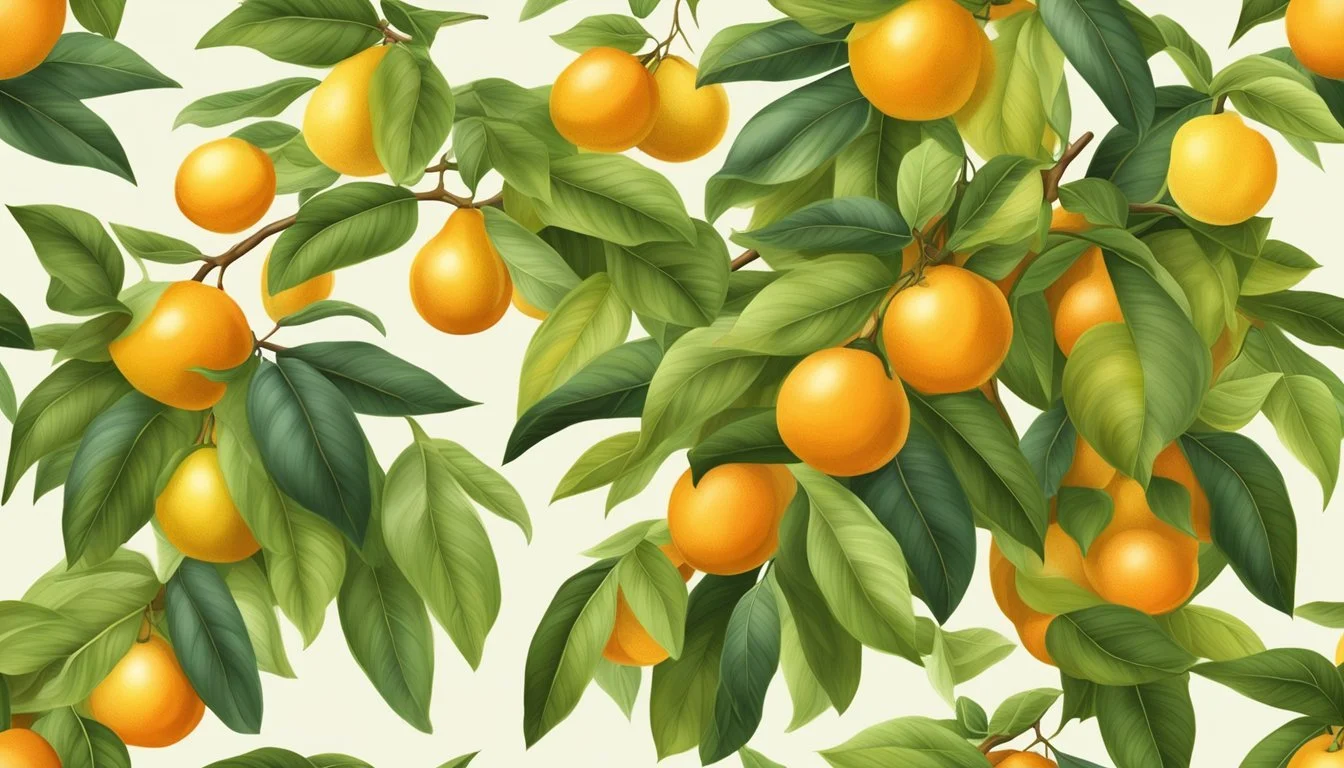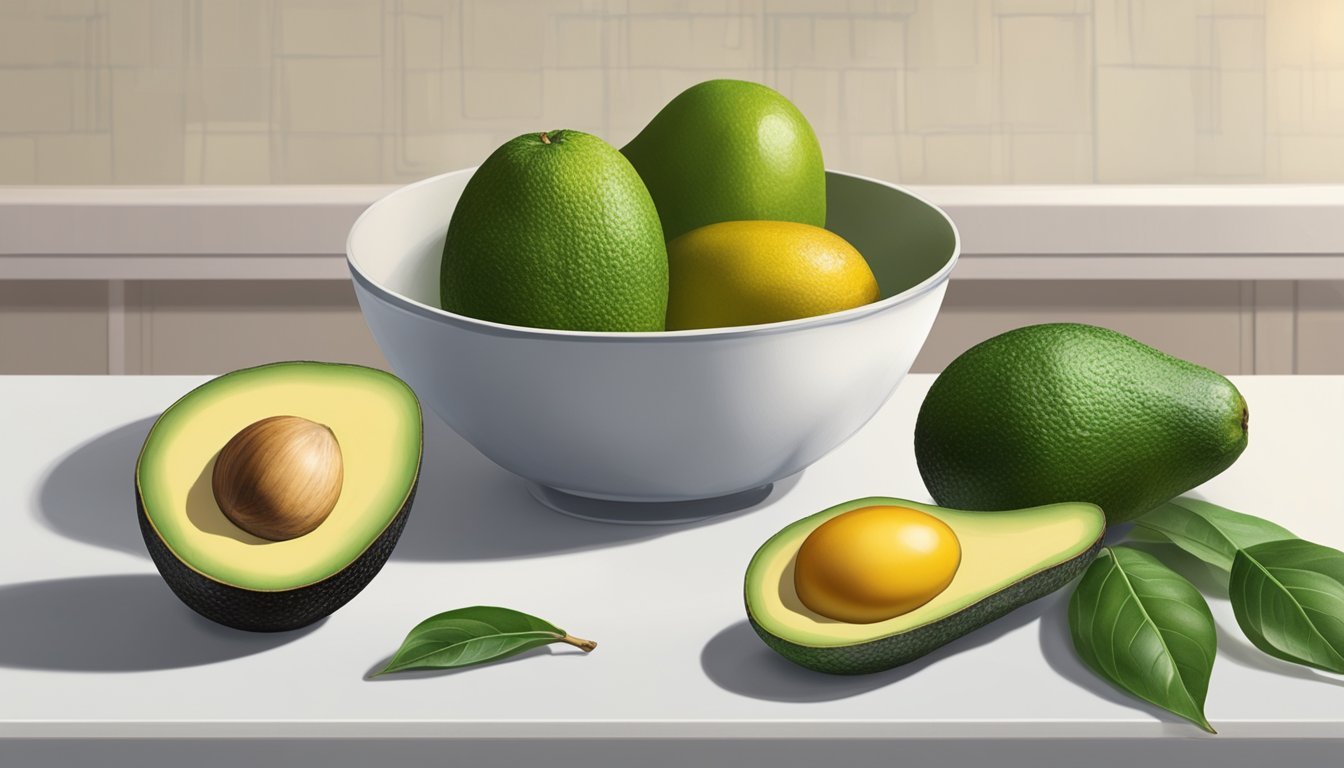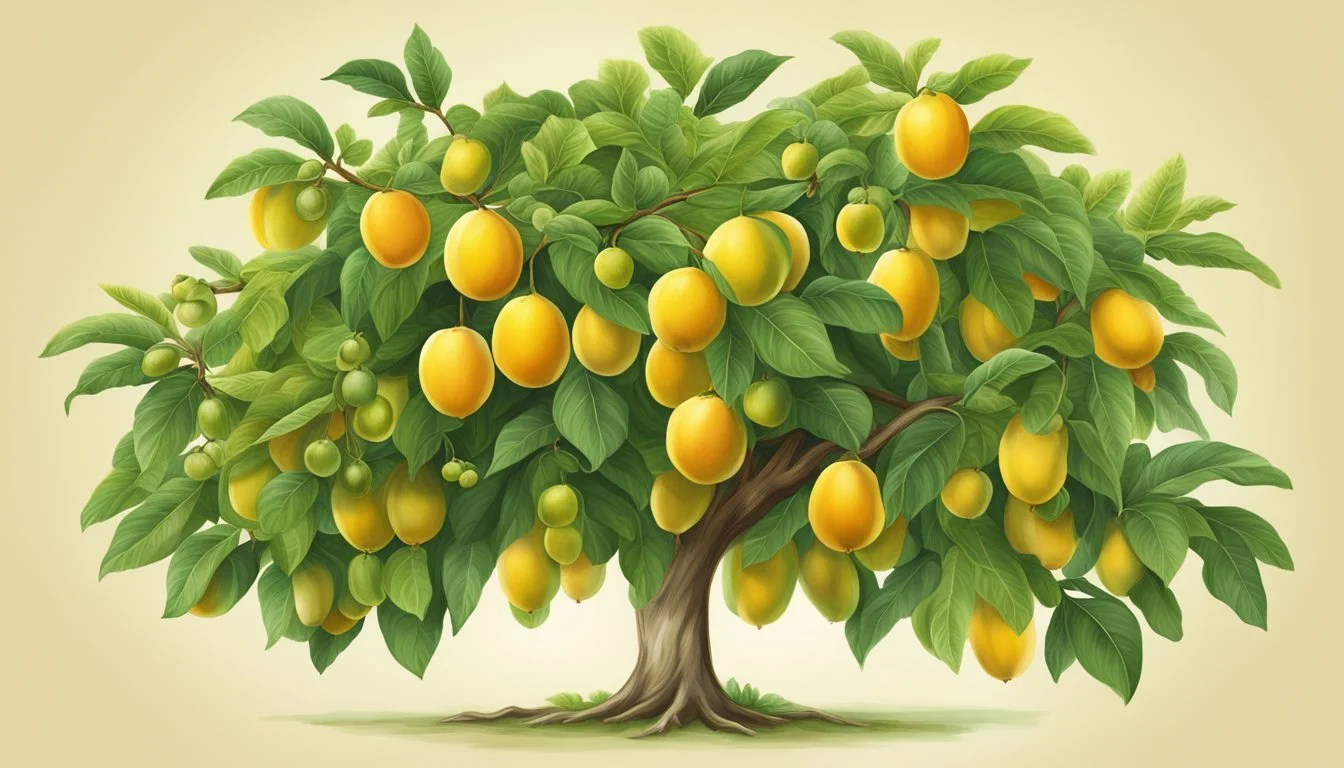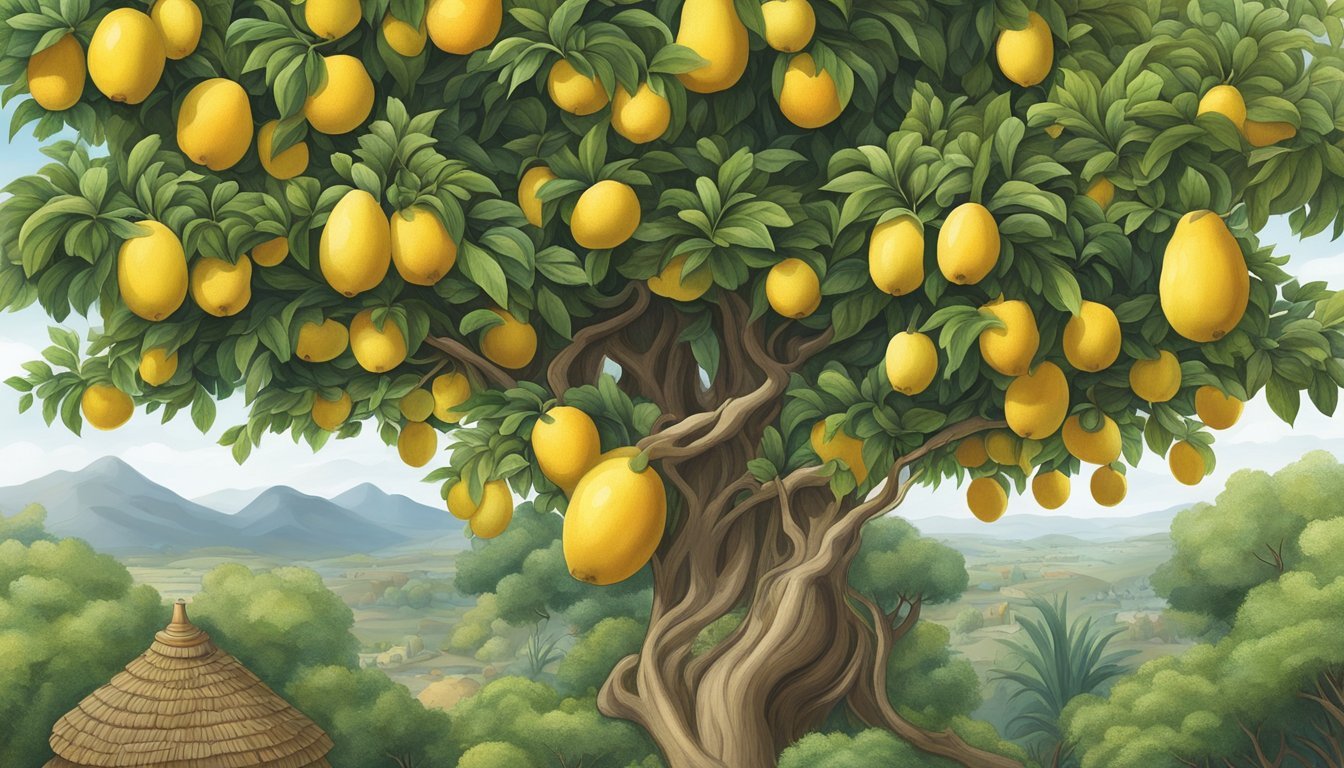How to Tell if Canistels Are Ripe
The Ultimate Ripeness Indicators
Determining the ripeness of a canistel, also known as egg fruit, is essential for enjoying its unique taste and texture. Ripe canistels exude a sweet aroma and yield slightly under gentle pressure, similar to how a ripe avocado would feel. The skin, which starts off green, transitions to a deep yellow color when the fruit is ready to eat. Inside, the texture of a ripe canistel resembles that of a hard-boiled egg yolk – smooth, custard-like, and bright yellow.
Canistels should be stored properly to ensure they ripen to perfection. These subtropical fruits (What wine goes well with fruits?) can be left to ripen at room temperature if they are still firm when picked or purchased. Once ripe, they can be stored in the refrigerator to extend their edibility. Eating canistels is straightforward once they are ripe—the skin is easily peeled, and the flesh can be scooped out, after removing the few large, non-edible seeds.
Key Takeaways
Ripe canistels are slightly soft to the touch and emit a sweet fragrance.
Canistels reach optimal ripeness at room temperature and can be refrigerated thereafter.
The fruit is consumed by peeling or cutting the skin and removing the seeds.
Identifying Ripe Canistels
When selecting a ripe canistel, several distinct characteristics become evident. These indicators range from color changes to texture nuances, and understanding them can greatly aid in identifying when the fruit has reached peak ripeness.
Color and Appearance
A ripe canistel will exhibit a skin color transition from a pale or dark green to a rich golden-yellow or marigold hue. The skin should appear smooth, shiny, and free of significant blemishes.
Texture and Firmness
Ripe canistels are soft to the touch and yield to gentle pressure, similar to a ripe avocado. However, they should not feel mushy or display significant indentations after pressing.
Fragrance and Flavor
Ripe canistels emit a sweet fragrance, indicative of their readiness for consumption. The flavor of a ripe canistel is sweet with a slightly nutty undertone, resembling the taste of a boiled egg yolk.
Stem and Skin Indicators
Check for the area surrounding the stem; it should feel soft, and the skin may begin to wrinkle when the fruit is ripe. Additionally, the presence of a stem can indicate freshness.
Weight Comparison
A ripe canistel may feel heavier for its size, as one would expect from a ripe fruit filled with moisture and natural sugars, compared to an underripe one.
Shelf Life and Overripe Signs
Canistels have a relatively short shelf life once ripe. Signs of an overripe canistel include excessively soft texture or areas that feel bruised when touched.
Varietal Differences in Ripeness
Different varieties of canistel may have slight variations in the ripeness indicators mentioned above. It's important to be aware of which variety one is dealing with to accurately gauge ripeness.
Ethylene Gas Influence
Canistels, like other tropical fruits, ripen due to the natural production of ethylene gas. The process can be expedited by placing the fruit in a paper bag with an ethylene-producing fruit like an apple or banana.
Optimal Storage and Ripening Methods
Knowing the proper storage and ripening methods ensures that canistels are enjoyed at their peak of flavor and texture. These techniques can help in managing ripeness and preventing spoilage.
At Room Temperature
Canistels ripen well at room temperature. They should be left on the counter away from direct sunlight, which can accelerate ripening evenly and naturally. This method is ideal for fruits that are still slightly green or firm to the touch.
Using a Paper Bag
To hasten ripening, place canistels in a paper bag along with an ethylene-producing fruit such as an apple or a banana. Ethylene gas emitted by these fruits will encourage the canistel to ripen faster. Check the bag daily to avoid overripening.
Refrigeration Tips
Once canistels have reached their desired level of ripeness, they can be stored in the refrigerator to prolong their shelf life. Store ripe fruit in the crisper drawer to slow down any further ripening processes. Green canistels should not be refrigerated, as cold temperatures can disrupt their ripening enzymes.
Accelerating Ripeness
Apart from using a paper bag with an avocado or apple, placing canistels in a bowl with other ripe fruits can also promote quicker ripening due to the shared ethylene gas environment. Keeping them at a consistent room temperature will assist in an even ripening process.
Preventing Overripening
To prevent canistels from becoming overripe, check them regularly while they are stored at room temperature or in a paper bag with other fruit. Remove any that reach the perfect ripeness to a cooler, less ethylene-rich environment, such as the refrigerator, to halt the ripening.
Preparing and Eating Ripe Canistels
When a canistel is ripe, it has a creamy and smooth texture reminiscent of a ripe avocado, with a sweet flavor profile that can enhance a variety of dishes. Here's how to prepare and enjoy this tropical fruit at its peak ripeness.
Simple Slicing and Serving
To serve a canistel, simply slice the fruit lengthwise around the seed, similar to how one would slice an avocado. Twist the halves apart, remove the large seed, and use a spoon to scoop out the rich flesh. The fruit's creamy consistency and sweet taste make it a delight to enjoy fresh.
Incorporating into Recipes
Ripe canistels lend their smooth, creamy texture to a range of recipes. They can be mashed and mixed into sauces, or pureed and added to cake batter for a moist and flavorful dessert. Cooking with canistel can introduce a unique and tropical sweetness to baked goods and sweet potato dishes.
Making Smoothies and Desserts
The custard-like texture of ripe canistel makes it an ideal ingredient for smoothies and desserts. Blend the pulp with other tropical fruits like papaya, or mix it with milk or yogurt to create a creamy, smooth concoction. Its natural sweetness also means less sugar is needed when incorporating it into cakes or custards.
Pairing with Other Foods
A ripe canistel pairs well with various foods. Enjoy it in salads mixed with vegetables and other tropical fruits. Its flavor complements breadfruit and papaya, and when diced, it can be a surprising addition to salsa. Garnish with toasted nuts for a delightful contrast in texture.
Understanding Canistel's Health Benefits
Canistels, also known as egg fruits, are recognized not only for their unique flavor but also for their impressive nutritional profile. This characteristic makes them a worthwhile addition to a balanced diet.
Nutritional Profile
Canistels are rich in vitamins and minerals, providing essential nutrients that are key to maintaining good health. Notably, they offer a good amount of Vitamin C, known for its antioxidant properties and a role in bolstering the immune system. Additionally, they supply a variety of B vitamins which are vital for energy metabolism and maintaining healthy skin and nerves. These fruits are a source of healthy fats that have a role in cardiovascular health. Beyond these, canistels are also appreciated for their content of calcium and iron—minerals crucial for bone health and blood oxygen transport, respectively.
Nutritional Contents per 100g of Canistel:
Energy: 141 kcal
Fat: 0.4g
Carbohydrates: 34.3g
Dietary Fiber: 9g
Sugars: 25g
Protein: 2g
Vitamin C: 21mg
Thiamin (B1): 0.07mg
Riboflavin (B2): 0.12mg
Niacin (B3): 1.9mg
Calcium: 28mg
Iron: 0.9mg
Dietary Use and Recommendations
Canistels are a versatile ingredient found in both sweet and savory dishes, contributing to their appeal in various dietary applications. In their ripe state, canistels exhibit a soft and creamy texture comparable to that of a baked sweet potato, making them an excellent dessert ingredient—enhancing nutrition without compromising taste. They are also a friend to those wishing to incorporate more healthy fats and vitamins into their diet, and can be seen as a strategic food for those managing HIV, due to their nutritional benefits which can support overall health and immune function. It is recommended to consume canistels while they are ripe to achieve the ideal taste and nutrient availability.
Growing and Harvesting Canistel
Canistel, a tropical fruit originating from Central America and occasionally found in some regions of Africa, thrives in warm climates. To cultivate this fruit, one should plant it in well-draining soil that receives direct sunlight. Root rot can occur in continuously moist soil, so proper drainage is crucial. It's important to water the tree thoroughly after planting.
For optimal growth, canistel trees should be situated in environments with temperatures ranging from 76-82°F (24-28°C). They can reach a mature size of 15-30 feet and may be grown in containers if adequately spaced to accommodate root growth.
The proper time to harvest this tropic fruit is when it turns yellow-orange. It is essential to handle canistel with care during harvest due to the delicate nature of their peel. Below is a brief guide:
Harvest: When fruit color shifts to yellow-orange
Ripening: Allow 3 to 10 days at room temperature for ripening
Ideal Temperatures: 76-82°F (24-28°C)
Post-Harvest: Ripe fruit should feel soft to the touch but not mushy
Once the canistel is ripe, it exudes a consistency comparable to meat, which is why it's sometimes known as "egg fruit." The flesh's texture has a close resemblance to a hard-boiled egg yolk, which may account for its secondary moniker.
The seeds of canistel are sizable, black, and glossy, typically found in the fruit's central region. After the fruit falls or is picked during late fall or on as needed basis, storage is the next step. Ripe canistel can be refrigerated where it will remain suitable for consumption for several days.
Cultural Significance and History
The canistel, often positioned among tropical fruits of cultural importance, plays a unique role in its native regions' food heritage. Its history is intertwined with traditional practices and has experienced a journey from its origins to various parts of the world.
Origin and Spread
The canistel (Pouteria campechiana) originated in southern Mexico and Central America. Mexico is notable for being the cradle of this fruit, which belongs to the family Sapotaceae. Canistel has spread to various tropical regions across the globe, including countries in Asia and Africa, due to its adaptability to warm climates. In these regions, the fruit is not just consumed, but is also part of the agricultural landscape, contributing to local culture and economy.
Traditional Uses and Customs
Traditionally, canistel is utilized in a variety of culinary customs. In Central America and the Caribbean, large yellow canistel fruits have been a staple, similar to how avocados are used for guacamole or how toast is paired with avocado slices in contemporary culture. The fruit's flesh, dense and sweet, is often used in desserts and is sometimes combined with other ingredients like rice or incorporated into beverages, making it a versatile component in traditional recipes. Its texture and taste have made it an ideal substitute for egg yolks in certain dishes, which is reflected in its nickname "eggfruit." Additionally, like many other fruits, it can be found in grocery stores within the regions where it grows. The canistel's presence in cultural traditions highlights the fruit's significance beyond mere consumption, symbolizing the integration of diverse food elements such as fruits and vegetables into cultural identity.
Buying Tips and Key Considerations
When selecting canistels, also known as egg fruits, at the grocery store, it's crucial to consider ripeness, seasonal availability, price, and quality, as well as potential damage from ethylene gas. To ensure a pleasant experience with this tropical fruit, one must pay attention to a few specific details.
Selecting Canistels at the Grocery Store
Skin Color: Canistels should have a vibrant yellow skin when ripe. Avoid fruits with green patches, as these are not fully ripe.
Gentle Pressure: Apply gentle pressure to the fruit; a ripe canistel yields slightly to pressure but should not feel soft or bruised.
External Damage: Examine for any bruises or external damage that can impact the flesh inside.
Understanding Seasonal Availability
Canistels are typically in season during the fall and winter months.
Purchasing in-season canistels ensures the best flavor and may also be reflected in a lower price.
Evaluating Price and Quality
Compare prices across vendors to find who offers the best balance of price and quality.
Remember that a good avocado may serve as a price reference, given that exotic fruits often have similar pricing scales.
Checking for Ethylene Damage
Canistels, like apples, are sensitive to ethylene gas, which speeds up ripening and may cause damage.
Store canistels away from fruits that emit high levels of ethylene to avoid premature spoilage.
Frequent Questions About Canistels
When selecting canistels, one often ponders how to discern the ripeness, methods of storage, and ways to incorporate them into meals. This section seeks to address common inquiries surrounding canistels, from identifying ripeness to culinary applications.
Ripe vs. Unripe Indicators
Ripe Canistel:
Texture: Soft to the touch, similar to a ripe avocado.
Color: Deep yellow akin to a ripe mango.
Skin: May yield slightly under pressure, indicating ripeness.
Unripe Canistel:
Texture: Firm, comparable to an underripe avocado.
Color: Lighter in hue, lacking the characteristic deep yellow of ripeness.
Skin: Resists pressure, remains unyielding.
Health Related Queries
Nutritional Profile:
Ripe canistels boast a rich assortment of vitamins, particularly Vitamin A and C.
Health: Integrating ripe canistels into one's diet can contribute nutritional benefits, but they are not known to treat or affect any illnesses, including HIV.
Storage and Preservation Concerns
How to Store Canistel:
Refrigerator: Place ripe canistels in the refrigerator to extend freshness.
Freeze: For longer storage, ripe canistels can be frozen, preferably after removing the flesh from the skin and seed.
Overripe Canistel:
If a canistel has become overripe, it can still be utilized in various recipes to minimize food waste.
Culinary and Recipe Curiosities
Recipe Ideas:
Canistel Puree: Blend ripe canistel flesh to create a puree that pairs well with breadfruit or as a base for rich, custard-like desserts.
Salads: Dice ripe canistel and incorporate it into salads for a burst of tropical sweetness.
Cooking:
Canistels are versatile in culinary applications, from simple preparations like mashing for a spread similar to guacamole to complex dessert recipes.
Final Thoughts
When judging the ripeness of canistel, sensory cues take precedence. A ripe canistel will exhibit a smooth texture akin to a hard-boiled egg yolk, not only in feel but also in its vibrant yellow color. It should yield slightly under gentle pressure, indicating a custard-like consistency which is a hallmark of its readiness for consumption.
The ripe fruit's flavor is particularly distinct—it carries sweet notes reminiscent of pumpkin or sweet potato with a hint of vanilla. The canistel's culinary applications are diverse, from being savored raw to being incorporated into various desserts. Its compatibility with art may not be overt, yet its rich color and texture offer an inviting palette for creative presentation in gourmet dishes.
A ripe canistel should be:
Yellow colored
Soft to touch
Smooth in texture
Given these qualities, they become not just a fruit but an experience, merging the simple act of eating with a sensory journey. They're not commonly found in every grocer's aisle but discovering and indulging in a ripe canistel can be rewarding for those seeking a unique tropical delicacy.





